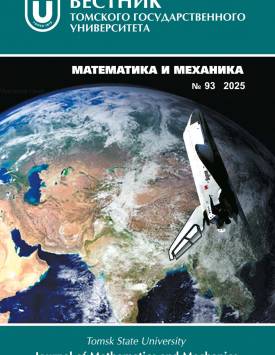Идентификация кинетических параметров процесса инактивации бактерий в присутствии паров йода
Представлены результаты экспериментального исследования процесса инактивации модельного штамма бактерий Lactobacillus casei ATCC 393 с использованием паров йода при различных температурах (T = 27, 37, 40 и 42°C). Проведена идентификация кинетических параметров на основе нелинейной модели инактивации Вейбулла изменения численности модельного штамма бактерий от времени инкубации в присутствии паров йода при температурах T = 27, 37, 40, 42°C. Задача идентификации требуемых кинетических параметров математической модели ставится как задача оптимизации, в ходе выполнения которой проводится последовательное решение обратной и прямой кинетических задач с целью подтверждения адекватности модели. Представлены результаты численных расчетов в соответствии с предлагаемым подходом на основе уравнения Вейбулла.
Ключевые слова
биокинетика,
математическая модель,
кинетические параметры,
модель Вейбулла,
коэффициент детерминации R2Авторы
| Ворожцов Александр Борисович | Томский государственный университет | доктор физико-математических наук, заведующий научно-исследовательской лабораторией высокоэнергетических и специальных материалов физико-технического факультета | abv1953@mail.ru |
| Бондарчук Иван Сергеевич | Томский государственный университет | инженер-исследователь лаборатории проблем опасных космических объектов физико-технического факультета | ivanich_91@mail.ru |
| Прокопчук Анна Олеговна | Томский государственный университет | кандидат биологических наук, старший научный сотрудник отдела инновационных программ и проектов | bio_1979@mail.ru |
| Марченко Екатерина Сергеевна | Томский государственный университет | доктор физико-математических наук, доцент, заведующая кафедрой прочности и проектирования физико-технического факультета | 89138641814@mail.ru |
| Соколов Сергей Дмитриевич | Томский государственный университет | младший научный сотрудник лаборатории нанотехнологий металлургии физико-технического факультета | sokolovsd95@yandex.ru |
Всего: 5
Ссылки
Pёrez-Rodriguez F. Development and application of predictive microbiology models in foods // Mathematical and Statistical Methods in Food Science and Technology / D. Granato, G. Ares (eds.). New York: John Wiley & Sons, 2014. P. 321-362.
Akkermans S., Smet C., Valdramidis V., Van Impe J. Microbial Inactivation Models for Ther mal Processes // Food Safety Engineering / A. Demirci, H. Feng, K. Krishnamurthy (eds.). New York: Springer, 2020. P 399-420. (Food Engineering Series).
da Silva A.K., Perim M.D., Brito L.M., Alvarenga V.O. Basic Concepts for Predictive Micro biology // Basic Protocols in Predictive Food Microbiology. Methods and Protocols in Food Science / V.O. Alvarenga (ed.). New York: Humana, 2023, P. 1-31.
Van Boekel M.A.J.S. Kinetic Modeling of Food Quality: A Critical Review // Comprehensive Reviews in Food Science and Food Safety. 2008. V. 7, № 1. P. 144-158.
Huang L. Dynamic identification of growth and survival kinetic parameters of microorga nisms in foods // Current Opinion in Food Science. 2017. V. 14. P. 85-92.
Psomas A.N., Nychas G.J., Haroutounian S.A., Skandamis P.N. Development and validation of a tertiary simulation model for predicting the growth of the food microorganisms under dynamic and static temperature conditions // Computers and Electronics in Agriculture. 2011. V. 76, № 1. P. 119-129.
Dolan K.D., Mishra D.K. Parameter estimation in food science // Annual Review of Food Science and Technology. 2013. V. 4. P. 401-422.
Clermont G., Zenker S. The inverse problem in mathematical biology // Mathematical Bio sciences. 2015. V. 260. P. 11-15.
Penalver-Soto J.L., Garre A., Esnoz A., Fernandez P.S., Egea J.A. Guidelines for the design of (optimal) isothermal inactivation experiments // Food Research International. 2019. V. 126. Art. 108714.
Reverberi A.P., Meshalkin V.P., Butusov O.B., Chistyakova T.B., Ferretti M., Cardinale A.M., Fabiano B. Organic and Inorganic Biocidal Energetic Materials for Agent Defeat Weapons: An Overview and Research Perspectives // Energies. 2023. V. 16, № 2. Art. 675.
Bevilacqua A., Speranza B., Sinigaglia M., Corbo M.R. A Focus on the Death Kinetics in Predictive Microbiology: Benefits and Limits of the Most Important Models and Some Tools Dealing with Their Application in Foods // Foods. 2015. V. 4, № 4. P. 565-580.
Corradini M.G., Peleg M. A model of microbial survival curves in water treated with a volatile disinfectant // Journal of Applied Microbiology. 2003. V. 95, № 6. P. 1268-1276.
Peleg M. Modeling the dynamic kinetics of microbial disinfection with dissipating chemical agents - a theoretical investigation // Applied Microbiology and Biotechnology. 2021. V. 105, № 2. P. 539-549.
Brown W.K., Wohletz K.H. Derivation of the Weibull distribution based on physical connection to the Rosin-Rammler and lognormal distributions // Journal of Applied Physics. 1995. V. 78, № 4. P. 2758-2763.
peleg m. advanced quantitative microbiology for foods and biosystems: models for predicting growth and inactivation. Boca Raton, FL: CRC Press, 2006.
Aragao G.M.F., Corradini M.G., Normand M.D., Peleg M. Evaluation of the Weibull and log-normal distribution functions as survival models of Escherichia coli under isothermal and non-isothermal conditions // International Journal of Food Microbiology. 2007. V. 19, № 3. P. 243-257.
Van Boekel M.A.J.S. On the use of the Weibull model to describe thermal inactivation of microbial vegetative cells // International Journal of Food Microbiology. 2002. V. 74, № 1-2. P. 139-159.
Pearce J.A.Comparative Analysis of Mathematical Models of Cell Death and Thermal Damage Processes // International Journal of Hyperthermia. 2013. V. 29, № 4. P. 262-280.
Bondarchuk I., Perevozkin V., Bondarchuk S., Vorozhtsov A. Identification of the Kinetic Parameters of Thermal Micro-Organisms Inactivation // Applied Sciences. 2022. V. 12, № 22. Art. 11505.
Бондарчук И.С., Бондарчук С.С. Кинетика гомогенных химических реакций: методы решения в Excel. Томск: Изд-во Том. гос. пед. ун-та, 2018. 263 с.
Mahmoud B.S.M., Bhagat A.R., Linton R.H. Inactivation kinetics of inoculated Escherichia coli O157:H7, Listeria monocytogenes and Salmonella enterica on strawberries by chlorine dioxide gas // Food Microbiology. 2007. V. 24, № 7-8. P. 736-744.
Mahmoud B.S.M., Linton R.H. Inactivation kinetics of inoculated Escherichia coli O157:H7 and Salmonella enterica on lettuce by chlorine dioxide gas // Food Microbiology. 2008. V. 25, № 2. P. 244-252.


 Вы можете добавить статью
Вы можете добавить статью